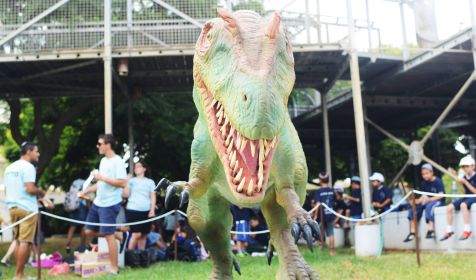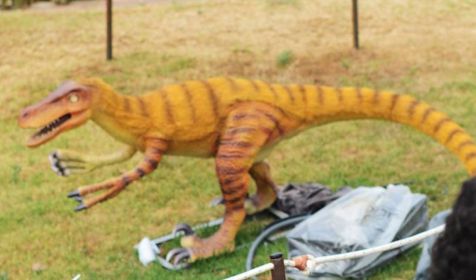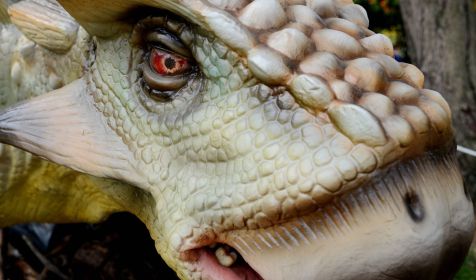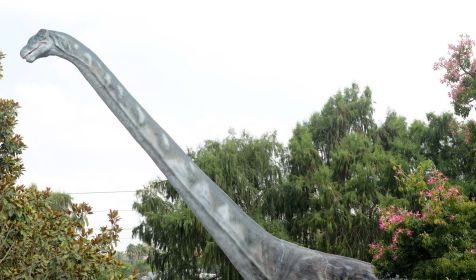The dinosaur exhibition at the Weizmann Institute of Science does not ignore the circus attraction of the huge, lost creatures, but it is meticulously faithful to scientific knowledge.
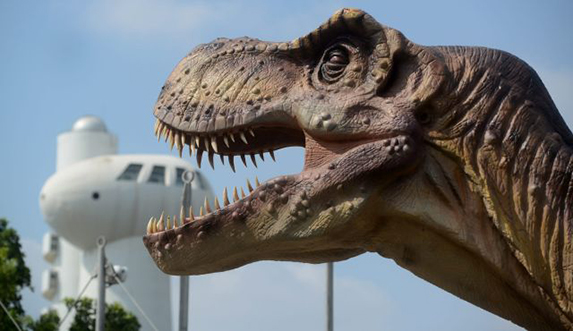
A hungry dinosaur at the Clore Garden of Science, Weizmann Institute of Science. Photo by Daniel Chechik
The dinosaur exhibition at the Weizmann Institute of Science does not ignore the circus attraction of the huge, lost creatures, but it is meticulously faithful to scientific knowledge.
When the principal curator of the Natural History Museum in London was asked to guess how long it took to set up the exhibition "Dinosaurs — the Giants of the Past, the Science of the Future" in the Clore Garden of Science at the Weizmann Institute, she was somewhat hesitant. Finally she told her Israeli colleague, Dr. Naama Charit-Yaari, that from her familiarity with Israeli purposefulness she guessed that setting up such a complicated project took only two years in Israel.
Charit-Yaari assumed the position of principal curator of the Clore Garden of Science six months ago. Since then she has managed to conceive of the dinosaur exhibition, order the huge exhibits from a Chinese factory specializing in museum models and mount the exhibition. It opened two weeks ago, with displays around the park and in an interior gallery and with activities suited to children of all ages.
Today, life-size models of dinosaurs from the Mesozoic Era occupy the Garden of Science, scattered among the permanent interactive exhibits on the basic principles of physics, chemistry and biology. These contemporary dinosaurs, made of a plastic substance and painted according to the scientific research, move their heads and their limbs and some even issue ear-splitting sounds.
This is an exhibition of extremes: Among other things, it displays the largest dinosaur ever discovered (which weighed about 100 tons and was over 30 meters long), the dinosaur with the smallest brain relative to its size (about 80 grams of brain for an animal weighing almost five tons) and the smallest, the lightest and the earliest dinosaurs.
There are several surprises in the Garden of Science, particularly the strong colors of some of the models and the feathers on others. Presenting the rich variety of dinosaurs, from the smallest to the largest and from the monochromatic to the colorful, emphasizes the dramatic nature of their total extinction, which erased a broad and unique spectrum of living creatures from the face of the earth.
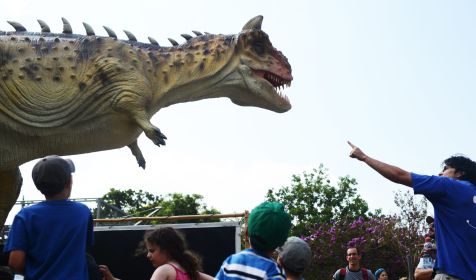
Also in evidence at the exhibition is the tension between the desire to maintain scientific criteria and precision and the desire to expand the circle of visitors to science museums. The dinosaurs are designed to attract an inquisitive audience and to bring them to the Garden of Science. Guided tours take the visitors among the exhibits and describe the latest research on the subject. Some of the research shatters fossilized and erroneous stereotypes.
Dinosaur research began in the 19th century, with the discovery of dinosaur fossils, though it could well be that the myths about dragons and griffins originated in the imaginations of ancient peoples who had come across fossilized remains. But modern technology has made it possible to create dinosaurs in a visual and tangible manner. There has been great progress in the study of fossils and dinosaurs over the past 20 years. Dinosaur remains undergo MRI scans and there are complex computerized simulations that enable scientists to estimate with great accuracy how they looked and moved; how they multiplied and what they ate.
It was inevitable that, as in every modern exhibition about dinosaurs, the legacy of the "Jurassic Park" films, based on the books by Michael Crichton, would hover over the Garden of Science. The first film in the series, directed by Steven Spielberg, was screened in 1993 and the 3D version that was issued recently to mark two decades since the original work, like the continuing anticipation of the fourth film in the series, highlights people's tremendous desire to see dinosaurs with their own eyes.
It was therefore quite a challenge to mount another exhibition devoted to dinosaurs. The exhibition in the Garden of Science, which has already been invited to travel abroad, meets the challenge effectively. It doesn't ignore the circus attraction of dinosaurs, but nor does it surrender to it. It is meticulous about faithfully representing scientific knowledge.
The added value of the exhibition can be enjoyed in the guided tours (which include mention of Spielberg's embarrassing mistakes), in lectures for children, which go well beyond the obsessive preoccupation with the Latin names of the ancient creatures, and in workshops devoted to flight. Young children are invited to discover "fossils" (hidden by the staff) and to match footprints to dinosaurs.
Anyone afraid of becoming extinct due the noontime heat in the Garden of Science should enter the air-conditioned EcoSphere, at the far end of the park. From inside the round transparent building, as you walk among various types of climbing plants, you can look at the towering figure of a huge herbivorous dinosaur that stands outside. It’s a momentary glimpse of how the Mesozoic period may have looked in Rehovot.
A concurrent dinosaur exhibition at London’s Natural History Museum examines the broader issue the processes of extinction in nature. The disappearance of the dinosaurs from the face of the earth about 65 million years ago was preceded by additional events of mass extinction. Just as mammals began to flourish only after the dinosaurs had left the stage of history, the dinosaurs developed after an event — called the “great death” in the research — in which about 96 percent of marine creatures became extinct, as did a significant percentage of land-based vertebrates. The question as to whether we are today in the midst of another wave of extinction, to which man has contributed, becomes clearer during the visit to the exhibition at the Weizmann Institute.


